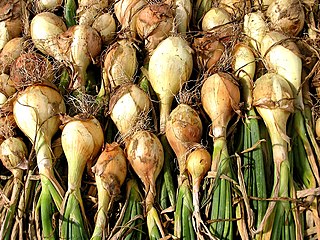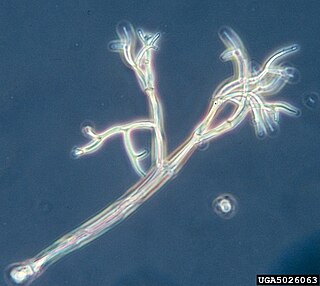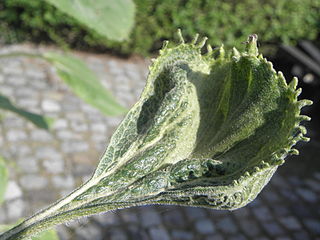
Downy mildew refers to any of several types of oomycete microbes that are obligate parasites of plants. Downy mildews exclusively belong to the Peronosporaceae family. In commercial agriculture, they are a particular problem for growers of crucifers, grapes and vegetables that grow on vines. The prime example is Peronospora farinosa featured in NCBI-Taxonomy and HYP3. This pathogen does not produce survival structures in the northern states of the United States, and overwinters as live mildew colonies in Gulf Coast states. It progresses northward with cucurbit production each spring. Yield loss associated with downy mildew is most likely related to soft rots that occur after plant canopies collapse and sunburn occurs on fruit. Cucurbit downy mildew only affects leaves of cucurbit plants.

Leaf vegetables, also called leafy greens, pot herbs, vegetable greens, or simply greens, are plant leaves eaten as a vegetable, sometimes accompanied by tender petioles and shoots. Leaf vegetables eaten raw in a salad can be called salad greens.

White onion or Allium cepa are a cultivar of dry onion which have a distinct light and mild flavour profile. Much like red onions, they have a high sugar and low sulphur content, and thus have a relatively short shelf life. White onions are used in a variety of dishes, such as those of Mexican and European origin. Their uses in dishes often relate to their mild nature, they are often included in dishes to provide a light, fresh and sour taste to dishes and are often added uncooked to dishes such as salads.

Hyaloperonospora brassicae, in the family Peronosporaceae, is a plant pathogen. It causes downy mildew of species of Brassica, Raphanus, Sinapis and probably other genera within the Brassicaceae. In the past, the cause of downy mildew in any plant in the family Brassicaceae was considered to be a single species Peronospora parasitica. However, this has recently been shown to be a complex of species with narrower host ranges, now classified in the genus Hyaloperonospora, for example Hyaloperonospora parasitica on the weed Capsella bursa-pastoris. From the perspective of plant pathology, Hyaloperonospora brassicae is now the name of the most important pathogen in this complex, attacking the major agricultural and horticultural Brassica species. Other significant Brassicaceous hosts are attacked by different species in the complex, e.g. horseradish by Hyaloperonospora cochleariae, wallflower by Hyaloperonospora cheiranthi.

Hyaloperonospora parasitica is an oomycete from the family Peronosporaceae. It has been considered for a long time to cause downy mildew of a variety of species within the Brassicaceae, on which the disease can cause economically important damage by killing seedlings or affecting the quality of produce intended for freezing. Hyaloperonospora parasitica causes downy mildew on a wide range of many different plants. It belongs to the Kingdom Chromista, the phylum Oomycota, and the family Peronosporaceae. The former name for H. parasitica was Peronospora parasitica until it was reclassified and put in the genus Hyaloperonospora. It is an especially vicious disease on crops of the family Brassicaceae. It is most famous for being a model pathogen of Arabidopsis thaliana which is a model organism used for experimental purposes. Accordingly, the former Hyaloperonospora parasitica has been split into a large number of species. For instance, the taxonomically correct name of the parasite of the well-known model organism Arabidopsis thaliana is Hyaloperonospora arabidopsidis, not H. parasitica, whereas the pathogen of Brassica has to be called Hyaloperonospora brassicae.

Peronospora sparsa is an oomycete plant pathogen that causes downy mildew in berry producing plants; especially in the genus's Rubus and Rosa. Downy mildew plant pathogens are often host specific and cause problems in cloudberries, blackberries, boysenberries, strawberries, and arctic bramble. Since they are host specific, Peronospora sparsa will not cause downy mildew in grapes because a different plant pathogen causes downy mildew in grapes; Plasmopara viticola. Although it depends on the cultivar, symptoms do not normally start until later stages of disease and can look different on different plants. The most common symptoms include red lesions in the veins of leaves, with dry and deformed berries.
Peronospora trifoliorum, commonly known as downy mildew of alfalfa, is an oomycete plant pathogen infecting alfalfa.
Sclerophthora macrospora is a protist plant pathogen of the class Oomycota. It causes downy mildew on a vast number of cereal crops including oats, rice, maize, and wheat as well as varieties of turf grass. The common names of the diseases associated with Sclerophthora macrospora include "crazy top disease" on maize and yellow tuft disease on turf grass. The disease is present all over the world, but it is especially persistent in Europe.
Aphanomyces cochlioides is a plant pathogen that can affect commodity crops like spinach, Swiss chard, beets and related species. In spinach the pathogen is responsible for the black root "rot" that can damage plants.

Bremia lactucae is a plant pathogen. This microorganism causes a disease of lettuce denominated as downy mildew. Some other strains can be found on 36 genera of Asteraceae including Senecio and Sonchus. Experiments using sporangia from hosts do not infect lettuce and it is concluded that the fungus exists as a quantity of host-specific strains. Wild species, such as Lactuca serriola, or varieties of Lactuca can hold strains that infect lettuce, but these pathogens are not sufficiently common to seriously infect the plant.

Peronospora manshurica is a plant pathogen. It is a widespread disease on the leaves of soybeans and other crop plants. The fungi is commonly referred to as downy mildew, "leafspot", or "leaf-spot".

Plasmopara halstedii is a plant pathogen infecting sunflowers. The species is one of many pathogens commonly referred to as downy mildew. P. halstedii originated in North America.

Plasmopara viticola, the causal agent of grapevine downy mildew, is a heterothallic oomycete that overwinters as oospores in leaf litter and soil. In the spring, oospores germinate to produce macrosporangia, which under wet condition release zoospores. Zoospores are splashed by rain into the canopy, where they swim to and infect through stomata. After 7–10 days, yellow lesions appear on foliage. During favorable weather the lesions sporulate and new secondary infections occur.
Pseudoperonospora cannabina is a plant pathogen that causes downy mildew, which is a fungal-like disease caused by an oomycete.
Peronosclerospora sorghi is a plant pathogen. It is the causal agent of sorghum downy mildew. The pathogen is a fungal-like protist in the oomycota, or water mold, class. Peronosclerospora sorghi infects susceptible plants though sexual oospores, which survive in the soil, and asexual sporangia which are disseminated by wind. Symptoms of sorghum downy mildew include chlorosis, shredding of leaves, and death. Peronosclerospora sorghi infects maize and sorghum around the world, but causes the most severe yield reductions in Africa. The disease is controlled mainly through genetic resistance, chemical control, crop rotation, and strategic timing of planting.

Beet necrotic yellow vein virus (BNYVV) is a plant virus, transmitted by the plasmodiophorid Polymyxa betae. The BNYVV is a member of the genus Benyvirus and is responsible for rhizomania, a disease of sugar beet that causes proliferation of thin rootlets, and leads to a smaller tap root with reduced sugar content. Infected plants are less able to take up water, and wilting can be observed during the warm period of the year. If the infection spreads to the whole plant, vein yellowing, necrosis and yellow spots appear on the leaves, giving the virus its name.

Pseudoperonospora cubensis is a species of water mould known for causing downy mildew on cucurbits such as cantaloupe, cucumber, pumpkin, squash and watermelon. This water mould is an important pathogen of all these crops, especially in areas with high humidity and rainfall, such as the eastern United States. In most years the disease is an annual, late-season problem on squash and pumpkin in the eastern and central United States, however, since 2004 it has become one of the most important diseases in cucumber production. Considered a highly destructive foliar disease of cucurbits, successful breeding in the mid-twentieth century provided adequate control of downy mildew in cucumber without the use of fungicides. The resurgence in virulence has caused growers great concern and substantial economic losses, while downy mildew in other cucurbit crops continues to be a yearly hindrance.

Peronospora is a genus of oomycetes that are obligate plant pathogens of many eudicots. Most species in this group produce a downy mildew disease, which can cause severe damage to many different cultivated crops, as well as wild and ornamental plants. There are 19 genera that produce downy mildew, and Peronospora has been placed alongside Pseudoperonospora in the group of downy mildews with coloured conidia. Peronospora has far more species than any other genus of the downy mildews. However, many species have been moved from this genus to be reclassified to other or new genera. Among these was the most famous Peronospora species, formerly known as Peronospora parasitica, and now known as Hyaloperonospora parasitica. Now, the Peronospora species of most importance is likely the Peronospora tabacina. Peronospora tabacina causes blue mold on tobacco plants and can severely reduce yields of this economically important crop to the point where it has been classified as a bioweapon.

Peronospora hyoscyami f.sp. tabacina is a plant pathogen infecting tobacco that causes blue mold. It is an oomycete that is highly destructive toward seed plants. It is very prevalent in humid farming zones, like the southeastern and Eastern U.S., Canada, and countries bordering the Caribbean. The disease was first identified in 1921 in Florida and Georgia. Ten years later the same disease was found once again in the same region of the U.S. The disease began to spread into Virginia, Maryland, and North Carolina. A few years later, the disease reached Kentucky and Tennessee. In 1960, a blue mold epidemic spread in approximately eleven countries. There was approximately twenty five million dollars in losses which is nearly thirty percent of tobacco plants at the time. Each year, Peronospora hyoscyami is introduced as blue mold as windblown spores from outside the region by infected transplants.

Peronospora destructor is a plant pathogen. It causes downy mildew on leaves of cultivated and wild Allium. Allium cepa is most often affected, while Allium schoenoprasum (chives) and Allium porrum (leek) are only occasionally affected.














